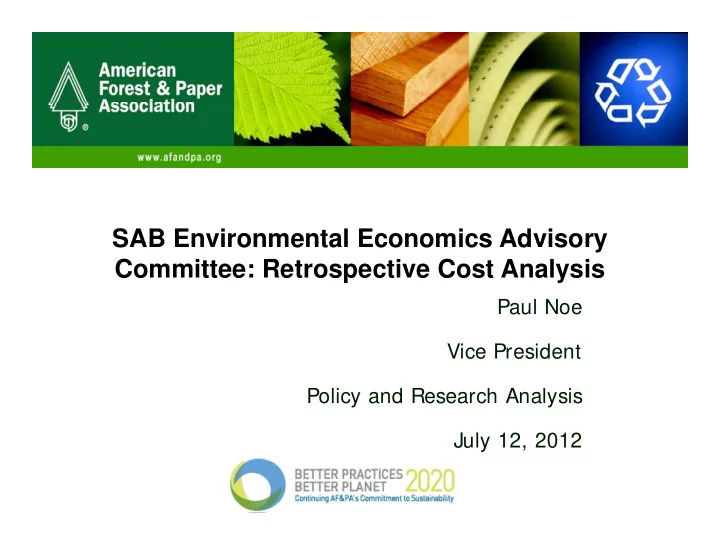

SAB Environmental Economics Advisory SAB Environmental Economics Advisory Committee: Retrospective Cost Analysis Paul Noe Paul Noe Vice President Policy and Research Analysis July 12, 2012
Overview AF&PA presented to SAB on April 19 th concerning water AF&PA presented to SAB on April 19 concerning water costs from 1990s Effluent Guideline for paper mills New information: June NCASI analysis of MACT/air y / costs for paper mills Discuss choice of baseline year and baseline costs: May 10 th AF&PA supplemental comments on water costs 2
Air Costs: Ex-post Three periods of Cluster MACT costs MACT I/Phase I MACT I/Phase I – low volume off-gases, 1999-2001 low volume off gases 1999 2001 MACT I/Phase II – high volume off-gases, 2002-2007 MACT II – chemical recovery combustion sources , 2001-2004 MACT II h i l b ti 2001 2004 First cost analysis relies on NCASI expenditure data $830 million thru 2003 (survey ended) baseline expenditures of $208M (very similar to NCEE’s, $202M) $202M) 3
Air Costs: Second analysis extrapolates from actual P&P mill costs Total Total - $1.8 B $1 8 B MACT I (phase I & II) = $1.7 B MACT II = $0.1 B – less than projected due to bubbling MACT II $0 1 B l th j t d d t b bbli NCEE looked at NCASI data thru 2002 $610 M in 1995 dollars becomes $633 M in 2002 dollars Ex-ante costs roughly $800 M (EPA and industry) 4
Air Cost Comparison Organization Period Projected Actual Underestimate Cost: Cost: (2002 $) ($2002) (2002 $) ($2002) Industry 1997-2007 $800 M $1.8 B 56% (1997) EPA (1997) All three rule $784 M NA 56% phases NCEE (2012) 1999-2001 NA $633 M 65% Expenditures as reported by mills Costs underestimated by more than a factor of two d d b h f f 5
Water Costs: baseline issues May 10 th supplemental Two issues: 1) when to “start the clock”; and 2) what is the baseline of non-Cluster Rule expenditures Start the Clock: Two periods of large investments totaling $3.8 billion in capital costs alone: Period 1: 1987 to 1993 ($1.8 billion; not necessary to d 98 993 ($ 8 b ll resolve; not included in ex ante projections; set aside) Period 2: Period 2: 1993 (Industry estimate) to 2000 1995 (EPA estimate) to 2000 1995 (EPA estimate) to 2000 6
Water Costs: baseline issues Reasons to include costs incurred starting in 1993 (industry starting point) v 1995 (EPA starting point) (industry starting point) v. 1995 (EPA starting point) 1988 consent decree required proposed rule by October 1993 Proposed rule issued October 1993 (FR on Dec 17, 1993) The direction on technology choices was clear before 1993 gy RTI Whitepaper documented that companies announced compliance projects after proposal in 1993 and completing th them by 1995 b 1995 Investments in earlier period based on the same technology were demonstrating desired results g 7
Water Costs: baseline issues Second Baseline Issue (NCEE Analysis): Which Second Baseline Issue (NCEE Analysis): Which costs are attributable to Cluster Compliance and which are “routine” and in the baseline? NCEE costs for compliance: $65 million (1998- 2000) EPA baseline level of spending: ~ $300 M per year in 1995-1997 Correct baseline: Slightly over $100 million per Correct baseline: Slightly over $100 million per year in 1987 8
Water Cost Comparison Organization Period Projected Cost Actual Cost Underestimate (2002 Dollars) (2002 dollars) NCASI 1993-2000 $1,875 million $1,895 million 1% NCASI 1995-2000 $1,445 million EPA 1995-2000 $1,079 million $ ll 43% NCEE 1998-2000 $68 million 96% Industry water total for all years was $3 8 B Industry water total for all years was $3.8 B EPA underestimated costs by about 43% in its projection; industry estimate was close to actual costs. y With $1.8 B in air costs, grand total for Cluster is: $5.6 B 9
Existing Policies Support Different Baseline OMB s Circular A 4 emphasizes the choice of baseline OMB’s Circular A-4 emphasizes the choice of baseline is very important and should consider world without the regulation EPA’s economic analysis guidance allows EPA to consider different baselines including cost from date of proposal or even earlier (see Chapter 5) f l li ( Ch t 5) Without Cluster regulations, mills could change pollution control practices ll ti t l ti 10
Recommend
More recommend